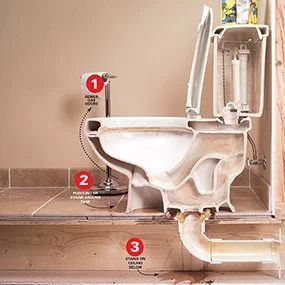A leaky toilet is not only an inconvenience but also a potential source of water wastage and damage. This comprehensive guide aims to delve deeper into the various aspects of toilet leaks, exploring causes, signs, and effective fixes to empower homeowners in tackling this common household issue proactively.
Common Causes of Toilet Leaks:
Toilet leaks can originate from a multitude of issues. A malfunctioning flapper, a damaged flush valve, loose or faulty connections, and even a cracked tank can all contribute to water escaping where it shouldn’t.
Understanding these root causes is essential for a targeted and effective repair.
Signs of a Toilet Leak:
Recognizing the signs of a toilet leak early on is crucial for preventing water damage and curbing unnecessary water expenses.
Beyond the obvious pooling of water around the base, signs can also include a persistent hissing or running sound, increased water bills, or unexplained water stains in adjacent areas.
Diagnosing a Leaky Toilet:
For those unfamiliar with the intricacies of toilet mechanics, a step-by-step guide on how to perform a DIY leak test proves invaluable.
This diagnostic process allows homeowners to identify the specific source of the leak, facilitating a more accurate and efficient repair.
Fixing a Leaky Flapper:
A worn or misaligned flapper is a frequent culprit behind toilet leaks. This section provides detailed instructions on how to replace or adjust the flapper, ensuring a proper seal and preventing the continuous flow of water into the bowl.
Repairing a Faulty Flush Valve:
A malfunctioning flush valve can lead to leaks and inefficient flushing. This part of the guide explores the steps involved in identifying and fixing issues related to the flush valve, which may include replacing it if necessary.
Tightening Loose Connections:
Loose connections within the toilet’s plumbing can be a less obvious but equally problematic cause of leaks.
This section highlights the critical areas to check for loose fittings and provides guidance on properly tightening them to eliminate leaks.
Addressing a Cracked Tank:
Though less common, a cracked toilet tank can be a source of persistent leaks. Readers are guided through the process of assessing and addressing tank cracks, whether through a DIY repair or the need for a complete replacement.
FAQs:
Q1: Can a leaking toilet cause water damage?
A1: Yes, a leaking toilet can lead to water damage to your flooring and subfloor if not promptly addressed. Additionally, it can promote mold growth and compromise the structural integrity of your bathroom.
Q2: How much water does a leaking toilet waste?
A2: A leaking toilet can waste hundreds of gallons of water per day, significantly impacting your water bill and contributing to environmental concerns related to water conservation.
Q3: Can I use food coloring to detect a toilet leak?
A3: Yes, placing a few drops of food coloring in the tank and checking for color in the bowl after some time is a simple and effective test to identify leaks and their sources.
Q4: Is it necessary to hire a plumber for toilet leak repairs?
A4: While some issues can be resolved through DIY fixes, consulting a plumber is advisable for complex leaks or if you are unsure about the repair process to ensure a thorough and lasting solution.
Q5: How often should I check for toilet leaks?
A5: Performing a routine check for toilet leaks at least once a year is recommended. This proactive approach helps catch and address potential issues early, minimizing the risk of extensive damage.
Q6: Are there water-saving alternatives for toilets?
A6: Yes, consider installing low-flow toilets or dual-flush models to not only conserve water but also reduce the risk of leaks, promoting sustainability in your household.
Q7: Can a running toilet be a sign of a leak?
A7: Yes, a constantly running toilet is a clear indication of a leak, and addressing it promptly is crucial to prevent water wastage and potential damage to your plumbing system.
Conclusion:
Toilet leaks, while common, are manageable issues that require attention and prompt action. By gaining an understanding of the causes, recognizing early signs, and implementing the appropriate fixes, homeowners can maintain an efficient and leak-free toilet. This not only contributes to water conservation but also leads to significant cost savings over time, promoting responsible and sustainable home management.

A group of home improvement enthusiasts and bathroom design experts, combines in-depth knowledge and a shared passion to deliver engaging, informative content that guides readers through the world of bathroom innovation and style.

Leave a Reply